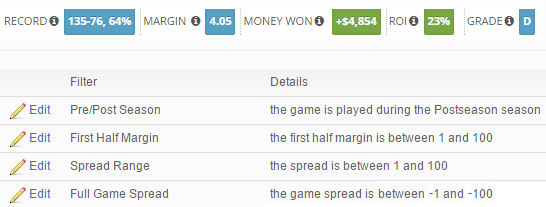Second Half Betting Rules

There was a time when football punters had few options other than betting in the Match Winner markets. But those days are long gone. Now a typical Premier League or Champions League game will offer hundreds of different markets to bet in.
Some of these markets often appear quite similar, which can lead to confusion. One example is a pair of markets that focus on the two halves of a football match: the Half-Time/Full-Time and Win Both Halves markets. Here’s a handy guide to telling these two types of bet apart, and profiting from both.
Football Wager Specific Rules 1 st half betting – The first half must be completed for wagers to have action 2 nd half betting – Game must go 55 minutes for 2 nd half wagers to have action. Overtime counts towards 2 nd half wagers. Las Vegas Sports Betting provide live 2nd half NCAA Football Odds located below, those lines are only available for 15-20 minutes during half time. Need a Sportsbook to place your 2nd half NCAA College Football Bet? Try one of our recommended Sportsbooks.
What is a Half-Time/Full-Time bet?
With a Half-Time/Full-Time bet, you have to do more than pick the winner of the game. To bet in this market, you are required to choose the Half-Time ‘result’ and the Full-Time result.
There are three options for each (Home Win, Away Win or Draw) and therefore a total of nine combinations in total, all of which will be priced up based largely on the odds in the Match Winner market. These odds can be quite high, particularly on the more unlikely outcomes, such as Home/Away or Draw/Away when the home team is much stronger than their visitors.
What is a Win Both Halves bet?
In a Win Both Halves bet you are required to pick whether Team A or Team B will win both halves of the match. These will generally be your only two options, although you may also sometimes be able to back ‘Neither’ and if you are betting with a Betting Exchange, you will also often be able to bet against Team A or Team B winning both halves, as well as laying all four options.
The essence of this bet, however, is in deciding whether either team will be able to ‘win’ both halves of the game (and by implication, win the whole game).
Spot the Difference
At first glance, there appears to be a degree of overlap between these markets. In particular, many newcomers make the mistake of assuming that backing Team A/Team A in the Half-Time/Full-Time market is the same as backing Team A to Win Both Halves.
In fact, these are distinct bets. In the first, you are counting on Team A being in the lead at Half-Time AND at Full-Time. They may, in the process, concede more than they score in the second half, but as long as they were leading at half-time and go on to win the game, you will win your bet.
But a bet on the Win Both Halves market is effectively a bet on two separate mini-games of 45 minutes each. If you back Team A to Win Both Halves, then you need them to outscore their opponents in BOTH halves.
If they lead 3-0 at half-time but the second half is goalless, your bet will be a loser. This is a vital distinction to bear in mind. Many novice punters overlook it and are frustrated to find their bet has lost when they thought they’d won.
How You can win and lose with both types of bet
To work out whether you are a winner or loser with both these bet types, you therefore need to approach each of them in a different way. When you bet on the Half-Time/Full-Time result, you are betting on the state of the game at two key points: the end of the first half and the end of the match.
Getting one of those aspects correct is not enough; you need to get both right. If you go for Manchester City/Manchester City and they win 4-0 having gone into the break goalless, you will lose your bet, even though you got the full time result correct.
Weighing up a Win Both Halves bet requires a different approach. With this kind of bet you should treat each half of the match as a game within itself. To be successful with a Win Both Halves bet, you effectively have to correctly predict the outcome of two 45 minute games.

Let’s say Liverpool are beating Stoke City 4-0 at half-time, then concede a goal in the second half and end up winning 4-1. If you had backed Liverpool/Liverpool in the Half-Time/Full-Time market, you would have won your bet, but if you’d backed Liverpool to Win Both Halves, you would lose, because while they ‘won’ the first half 4-0, they ‘lost’ the second half 1-0.
Halves Betting: Advantages, Disadvantages and Strategies

One of the advantages of the Half-Time/Full Time market is that it can often produce some big odds, particularly if you back one team to be leading at Half-Time and another at Full-Time.
The downside to this market is that it can be volatile. Football is a low scoring game in which it is hard enough to predict the outcome of a ninety minute game, let alone the course of a 45 minute half.


It’s also the case that some teams are slow starters while others can run out of steam in the second half. Punters who regularly play in the Half-Time/Full-Time market take care to inform themselves about the characteristics of teams they are likely to be betting on and also learn take a patient, long term approach to success.
One common strategy for this market is to look for games that you are confident will be won by one of the two teams, then backing two options: Draw/Team A and Team/Team A. In this way, it is possible to profit from games where your chosen team dominates throughout and those matches where their opponents hold them off for the first half but eventually lose.
The advantage of betting in the Win Both Halves market is that you are likely to find bigger odds. For example, in a Champions League game between Barcelona and Manchester City, you might find that Barcelona/Barcelona in the Half-Time/Full-Time market might be priced up at 4/7 but in Win Both Halves market you might be able to back Barcelona at 5/4.
Of course, as we saw above, these two bets are not exactly the same, and this is where the downside of the Win Both Halves market comes in. Unlike with the Half-Time/Full-Time market, you can’t afford for the team you’ve backed to take their foot off the gas in the second half, just because they went in two or three goals up at half-time.
You need your chosen team to be trying hard throughout. Punters who specialise in this market will therefore prefer to back teams that are likely to be motivated to try to score as many goals as possible, particularly when they are up against opponents that struggle to come from behind, either because they have fragile morale or are set up to defend.
How Does Second Half Betting Work
Conclusion
The Half-Time/Full-Time and the Win Both Halves options, though more volatile than some football betting markets, can be an effective addition to any football punter’s portfolio.
Second Half Betting Rules Uk
By making sure that you understand the characteristics of both markets, as outlined above, and by taking the time to think through how each team is likely to approach a game, as well as weighing up their respective abilities, it is possible to land some good wins with these bets.